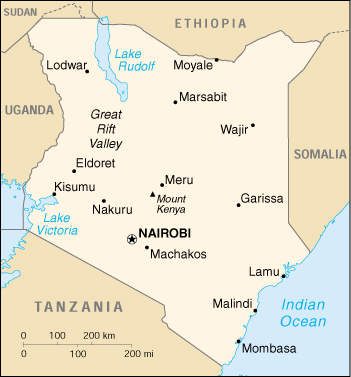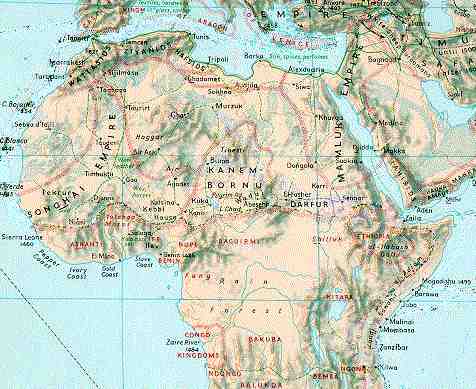
Democratic Republic of Congo |
The Nilotic family
contains some 29 to 53 languages. Determining the
precise number of Nilotic languages depends on
complex issues that involve degree of mutual
linguistic comprehension between speakers of
different language varieties, and ethnic
self-identity. Generally, linguists say that if
two language varieties are not mutually intelligible
between their respective speakers, then the varieties
should be called distinct "languages"
(rather than "dialects of a single
language"). However, intelligibility is a
matter of degree. For example, someone may understand
another language variety at about 75%. Does that make
the two varieties dialects, or separate
languages? If comprehension is at 70%, does
that make them separate languages?
Within Nilotic, there
are three sub-branches, according to linguist
Rainer Vossen (1983). These have been designated
"Western," "Eastern," and
"Southern." The labels refer to linguistic
groupings, and not primarily to geographical
distribution, though there is a rough geographical
reality to the terms.
|

Ethiopia |
Long before there were
written records,
Nilotic peoples
apparently migrated from the Nile River area as far
south as the region of modern Tanzania. Some Nilotic
groups had intensive contact with Cushitic
(Afro-Asiatic) peoples, and with Niger-Congo peoples.
This has resulted in mutual cultural and linguistic
impact across Nilotic, Cushitic, and Niger-Congo
language families.
Modernly, Nilotic
languages are spoken in the Democratic Republic of
Congo (DRC), Ethiopia, Kenya, Sudan, Tanzania, and
Uganda.
|

Kenya |
The Eastern Nilotic
branch
of the family extends from Sudan down into
Tanzania. Eastern Nilotic groups appear to have
had extensive interaction with Southern Nilotic
groups. As a result, they share many cultural and
linguistic patterns in common. For example, in
most languages of both Eastern and Southern Nilotic
groups, sentences begin with the verb. Also,
"Subject" and "Object" are
usually distinguished by tonal patterns on nouns, and
verb words are complex. Eastern Nilotic
languages include Bari, Teso-Turkana and other
closely related languages [or dialects], Otuxo, Maa, and now-extinct
Ongamo.
Southern Nilotic
languages are spoken in Kenya and
Tanzania. Some Southern Nilotic languages
include Datoga, Pakot, Endo, Saboat, and Nandi. (The
term "Kalenjin" is commonly applied to some
of these languages.) Southern Nilotic groups
appear to have had considerable contact with some
Cushitic (Afro-Asiatic) language groups.
|

Sudan |
Most Western
Nilotic languages are spoken in Sudan,
but they also extend into Ethiopia, Uganda, the
Democratic Republic of Congo, and Kenya. Some
Western Nilotic languages include Shilluk, Acholi,
Dinka, Dholuo, Nuer and Lango. Western Nilotic
languages usually have very short words, and
sentences tend to have Subject-Verb-Object order.
|

Tanzania |
Nilotic groups
have experienced significant
and sustained contact with outside influences over the past century.
These outside influences include colonialism and the
drawing of international boundaries across their
traditional areas (e.g., the Maasai straddle the
Tanzania-Kenya border; Luo are found in Kenya,
Uganda, and Sudan), mission activities,
western-oriented educational systems, establishment
of international cities such as Nairobi in their
traditional areas, tourists, national government
policies, etc. Also, a number of small ethnic
groups have been, and continue to be, absorbed into
larger Nilotic language groups.
For decades, a number
of Nilotic languages and cultures have experienced
significant disruption due to war, famine, and
movements to refugee camps in search of food, medical
attention, and safety. This has been especially
true for groups in the Sudan, northern DRC, and
Uganda; many speakers of Western Nilotic languages
are now found in Europe and the United States, as
well as in refugee camps throughout East Africa.
|

Uganda |
All these event have
significant implications for cultural and linguistic
survival into the Twenty-first century.
At present, the
number of speakers
per Nilotic language ranges from about 3.5
million for Dholuo (found in western Kenya and
Uganda), to 50 or fewer for some highly endangered
languages. Most Nilotic languages are somewhere
in between these two extremes, with a few hundred
thousand speakers.
. .
. . . . . . . . back to
Nilotic homepage
|
 The Nilotic
The Nilotic  The Nilotic
The Nilotic 




